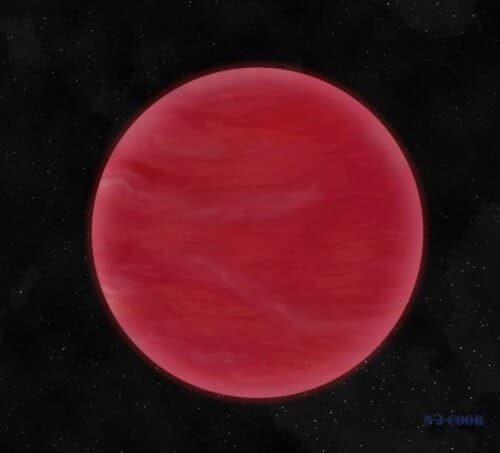An extreme example of a celestial body known as a brown dwarf, from which a red sky can be seen, was discovered by a team of astronomers from the Center for Astrophysical Research at the University of Hertfordshire.

An extreme example of a celestial body known as a brown dwarf, from which a red sky can be seen, was discovered by a team of astronomers from the Center for Astrophysical Research at the University of Hertfordshire.
Brown dwarfs are on the borderline between planets and normal stars. They are too large to be considered planets, but do not have enough mass to fuse hydrogen in their cores and develop into full stars. A valve is halfway between stars like the Sun and giant planets like Jupiter and Saturn. Sometimes they are described as failed stars. They have no internal energy source - so they are cold and pale and they stay cold for a long time.
A thin layer of clouds
The brown dwarf, known as ULAS J222711-004547, caught the attention of researchers due to its red appearance compared to 'normal' brown dwarfs. Follow-up observations using the "Very Large Telescope" (VLT) in Chile and using innovative data processing methods, showed that the reason for this oddity is the presence of a small layer of clouds in the upper atmosphere of the brown dwarf.
Federico Marocco, who led the research at the University of Hertfordshire said: "This is not the type of clouds we are used to seeing on Earth. The thick clouds in this particular brown dwarf are made of mineral dust, such as anastatite and corundum.
"Not only were we able to notice their presence, but we were also able to estimate the size of the dust grains in the clouds." The size of the dust grains affects the color of the sky. In a similar way to the old expression "Red sky at night, shepherd's delight." Red sky in the morning, shepherd's warning" used at sunrise and sunset to indicate weather changes. A red sky in a brown dwarf indicates that the atmosphere is full of dust particles and moisture. If our morning sky is red, it is because clear skies to our east allow the sun to shine beneath the layer of dusty clouds coming from the west. Conversely, in order to see red clouds in the evening, the sun must shine in a clear path from the west to the viewer in order to illuminate the clouds full of moisture and dust moving east. However, the recently discovered brown dwarf, ULAS J222711-004547, does not need a sunset or a sunrise - its atmosphere is different and the sky is always red.
The giant planets in the solar system, such as Jupiter and Saturn, show variation in cloud layers, including clouds containing ammonia and hydrogen sulfide as well as water vapor. The atmosphere observed in this brown dwarf is warmer and contains water vapor, methane and possibly a little ammonia, but unusually, it is dominated by clay-like mineral particles.
extreme atmospheres
Dr Avril Day-Jones from the Center for Astrophysical Research at the University of Hertfordshire, who contributed to the discovery and analysis, said: "Being one of the reddest brown dwarfs ever observed, ULAS J222711-004547 makes an ideal target for multiple observations to understand the weather in such extreme atmospheres."
By investigating the composition and variation in lighting and colors of this type of object, we can understand how the weather works on brown dwarfs and link this to large planets."

3 תגובות
🙂 Father, I think you don't talk to my father enough! Talk to each other and establish a uniform policy.
Really agree with Neta!
What's the point of the subtitle? She just repeated the first paragraph.